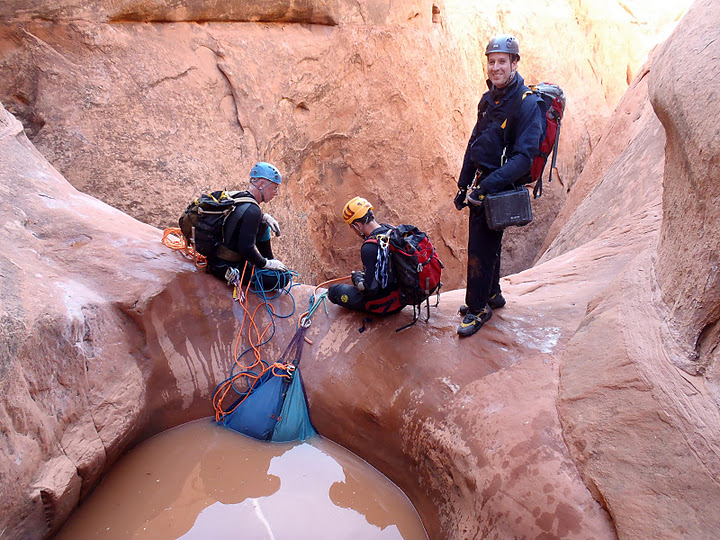Tommy Takes a Tumble - Preface: the WaterTrap Anchor
To understand the Tommy Takes a Tumble accident, some background on the SandTrap and WaterTrap will be useful. The SandTrap was invented by Steve Woodford for Lake Powell canyons where sand is available but other anchor options are sparse. We had previously used stacked Pot Shots in these situations, but they proved difficult as they had a small “sweet spot” – ie, the balance between security and retrievability had to be made very carefully; between “secure” and “retrievable” was only a very small window, that required skill and judgment to set properly.
This brought about the saying: “you must rappel only a little slower than if you were falling”, plus attention to very careful testing, and to the risk of the person going last.
The clever release mechanism of the SandTrap creates a big Sweet Spot where the anchor is both secure and retrievable. The SandTrap also is relatively easy to use – if it wiggles when people rap off it, add more sand. Having a relatively large group is very helpful because it provides lots of available testing. It helps if there are several people around the same weight as the anchor “owner”, the person going last.
When these canyons are wet, we have another problem – when sand is not available, could we use the water for anchors? Certainly seems possible, so we have been exploring possible “water traps”, inserts to the SandTrap that would allow for using water.
Jenny made up some custom drybags that tie into the SandTrap, then seal kinda like a drybag, with a pull-off stick release mechanism. At the same time, I had been working on a “ghetto version” using Hefty Trash Compactor bags with a simple release mechanism; my thinking being that to be useful the watertrap would need to be inexpensive and lightweight so people would carry it all the time. Jenny had used her WaterTrap successfully on several trips, and I had used mine 3 or 4 times successfully, but we had not been together on a trip where the WaterTrap was needed.
After using the WaterTrap a few times, it became clear that in many circumstances, the WaterTrap would be more secure, easier to set up, and easier to pull than the SandTrap. The WaterTrap when released consistently voids all the water quickly, and the effort required to pull the release mechanism is considerably less than the effort needed to dump the sand out of the SandTrap. Where a “steep wall” placement is available, the WaterTrap will work better; where a “flattish” placement only is available, the SandTrap would be a better choice.
An advantage to the SandTrap is that sand is 1.5 X to 2X denser than water. A disadvantage to the WaterTrap is that the ‘bag’ involved in either form has a specific maximum volume which may not be big enough (heavy enough) for flattish placements. (Jonathan and Steve have done one WaterTrap anchor using stacked trashbags.)
Conclusion: when used intelligently, the SandTrap and the WaterTrap are not dodgy, marginal anchors – they are “solid”, much better than some of the stuff we rap off of. Some have wondered why I was going last, being that I was not the lightest person in the group. If the anchor is marginal, the lightest person going last would be a good choice. But the Traps are not marginal if placed intelligently, therefore the anchor builder goes last, as the person morally culpable for what happens, and with the hope that this will help focus their full self-preservation instincts on the task. This usually happens - didn’t happen this time.


